Japan seems to have a special love for the Mini. There are, after all, a surprising 80,000 Minis registered there and specialty tuning shops for the little cars abound. A racing enthusiast would not be wrong in thinking that some of them must be race cars. Indeed, here at Fortech, (a foreign car repair shop in Northern California and Mini racing enthusiasts for twenty years), we have often heard about the wild Mini racing that takes place in Japan – where there are few rules governing vehicle modifications. After viewing a videotape of Japanese Mini racing, we were anxious to go and race there to see how well we could do.
THE PLANNING
The Fortech Mini’s trip to Japan started four years ago (ed: 1987-88) when my good friend, Kohei Saito, an accomplished artist who travels to Japan often, began making contacts with potential sponsors. On every trip, he would visit more shops, trying to get backing for our trip. We saw marginal success. Some shop owners actually came to California to see the Fortech Mini, but none would commit to the $30-40,000 required to race it in Japan.
As you can imagine, racing in a foreign country is an expensive proposition. Air transportation to and from Japan, for one race car and 1000lb of spares, is $17,000. Add to that the cost of air and rail passes for three people, for three separate trips. Then add the cost of renting a truck to transport the car, throw in a support vehicle, and the costly tolls required to travel on their roads. Our financial situation looked bleak.
Fortunately, we made a breakthrough in the summer of 1991. Kohei met a man named Kidehisa Ikeda, at, of all places, the Monterey Historic races. Ikeda was interested in seeing the Fortech Mini race in Japan, so when he returned to his Mini dealership, Garage Minimum, he began helping us look for sponsors.
In just a few months, Ikeda had secured sponsorship from four sources: “MRO—On your side,” Hokuriku Broadcasting Co. Ltd.; Korinbo 109, Fashion Boutique Complex Building; Kyodo Kokoku, an advertising agency; and Garage Minimum. At last, the “1992 Tour of Japan” was a reality for Fortech. We were scheduled to race at the Coca-Cola Mini Jamboree, on April 29; at the Club 305 Mini Meet at Fuji, on Aug. 29; and at the Historic Car Festival in Kanazawa, on Sept. 27.
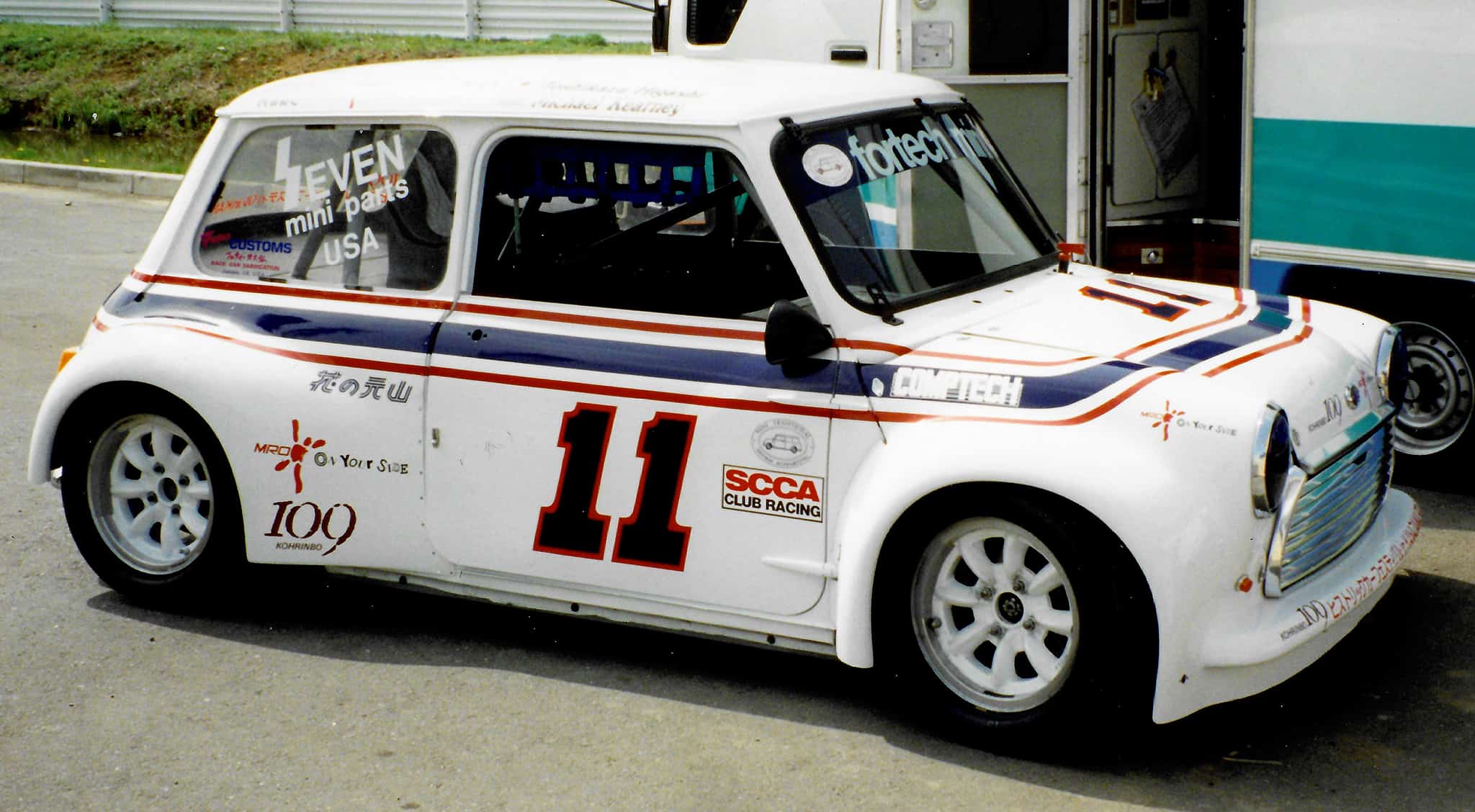
Now, we had to get the car ready. I really wanted it to be perfect, so once the trip was official, the Fortech crew (Bruce Weideman, Steve Maxwell, and myself) completely rebuilt the Mini. It was then painted to match our Japanese sponsor’s colors. Because we were the only non-Japanese racing team, out of 200 Minis, I wanted to show that “Made in America” meant something. I wanted to show that the SCCA takes its racing as seriously as anybody in the world.
The Track Tsubuku Circuit is 50km northeast of Tokyo in what was once strictly a farming community, but is now one of the world’s premier research and development centers for the electronics industry. The two-kilometer track has a lot to offer, including eight turns.
In my 25 years of racing, I haven’t seen a racing facility that equals Tsukuba. The first thing I noticed when we stepped on the racing surface for a morning walk-through was the width of the track–a whopping 60ft. The surface was perfectly smooth and looked like it had just been paved, even though it hadn’t. Thirty-foot sound walls, on the outside of corners that border the track, combine with the 96db sound limit, to make for quiet racing. Outside the track, one can barely hear the race cars.
THE CIRCUIT
The Tsukuba Circuit is fully FIA-approved, and has many safety features I haven’t seen in the U.S. My favorite is a series of huge foam cushions, each about four feet thick, laced in front of the guard rail. These barriers are much kinder to cars than tire walls.
The overhead lights at Tsukuba are much kinder on the eyes than a bank of driving lights on each car. In Japan, the race cars don’t need headlights; the tracks there are equipped with lights that compare to major league stadiums. It was just incredible to see the Tsukuba track lit up, and the paint sparkling on the cars as they raced.
Walking onto the front straight, you can’t help but notice the 20,000-seat covered grandstands. The pit lane has permanent garages assigned with car numbers. There are luxury suites above each garage for the “high-rollers.”
A four-story officials’ building is home for timing and scoring personnel, and for drivers’ meetings. I particularly liked the officials’ room on the bottom floor, stocked with computers and a full wall of television monitors showing the action on the track. Every race session is videotaped, and every part of the track is covered. Determining who did what to whom in a racing incident is not a problem at Tsukuba.
Like many tracks in the U.S., Tsukuba has good overnight camping facilities, with modern, clean, coin-operated showers. My wife especially liked the Japanese gardens and fountains that dot the facility.
If you were going to build a racetrack, it would be to your advantage to visit Tsukuba. They have a model facility on a relatively small piece of real estate.
THE COMPETITION
We saw one Mini with pull-rod suspension, others had Kevlar bodies, large displacement motors, ultra-light frames, and so on. Our car is legal in SCCA’s GT5, less the ballast, but our competition in Japan was obviously well-prepared. The attention to detail is what makes their cars appealing. I would say they’re conservative in their approach to suspension, however, considering there are no rules governing suspension type or minimum weight.
QUALIFYING
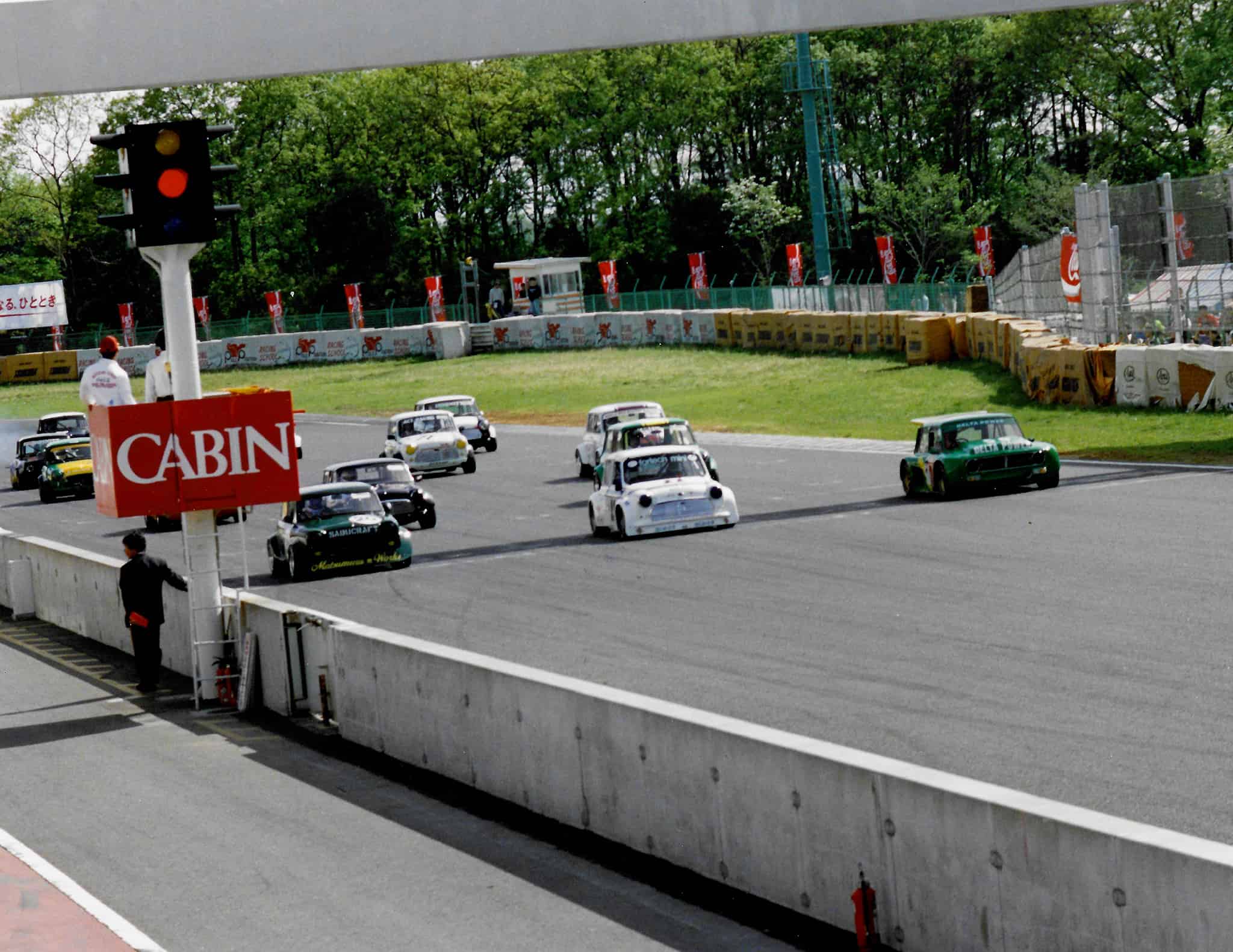 Usual Japanese standing start hurt getaway of Fortech Mini, with its four-speed transmission.
Usual Japanese standing start hurt getaway of Fortech Mini, with its four-speed transmission.
We had just three major problems after testing at Sears Point Raceway, before leaving for Japan. The first was an unknown driver. We had to use a Japanese driver for the first race, and our sponsor nominated Toshikazu Higashi. He had driven the track a lot, but not in a mini with slicks and a tube-frame chassis. Despite his lack of seat time (approximately 50 minutes total), and a rev limited set at 7800rpm, he broke the track record by a full second the first day out. He really did a good job and was thrilled to be competitive against cars that used to drive away from him. No problem there.
Our second worry was tires. Four days before leaving, we were informed that we couldn’t use our Goodyear tires; the car had to race on Japanese-made tires. I felt they had just taken away my secret weapon. I hadn’t been worried about our car behind several hundred pounds heavier, because I knew we had the tire advantage with Goodyear—hands down. We decided to use Bridgestone slicks and set the car up for the Goodyears, since we had no data on the Bridgestones. Luckily, the track was smooth enough and the race short enough (12 laps, or about 15 minutes) that the tires weren’t a problem.
The third problem turned out to be more of a nightmare that we thought possible. In Japan, all races have a standing start. This sounded neat at first, but then we realized that we would be the only car there with a four-speed transmission, and our first gear ratio is 1.68. It’s great for a rolling start, and you get to use all four gears on the track, but it wasn’t what we needed in Japan.
Our driver Higashi had a 10-minute qualifying session to decide his position on the grid. Considering the traffic and that I had forgotten to turn off the rev limited, he did well to qualify second.
Lunch break Before the racing began, Rover Japan sponsored some interesting on-track activities. Four new Minis were brought out and four teams then tried to squeeze as many people as they could into each Mini, and still shut the doors and trunk. I was rooting for the Rover Japan factory team the only all-girl team. But they only stuffed 16 people into the car—the winning team had 18.
Then, Rover rolled out a new Mini and gave it away in a drawing. Not a bad deal for simply buying a ticket to a car race. Finally, there was a radio-controlled Mini race which several of the race teams entered with cars painted just like their race cars. It was a great idea to get kids involved at the track.
THE RACE
Finally, it was showdown time. The cars were pushed out to the main straight and placed in their stating positions, three abreast on the front row, two per row from then on.
The five-minute board was displayed by one of the race queens, and the grid was cleared. The engines started, and I went up to the observation deck above the garages. I was just in time to see the green flag wave, which started the cars on a reconnaissance lap. The cars drove around the final turn, followed by the safety car, and stopped. The grid steward, at the rear of the field, waved a flag, turning the race over to the starter. In a matter of seconds, the starting lights went red, then green, and the race was on.
As expected, the Fortech Mini had a really bad start and fell back to the middle of the pack. Racing for Turn One, a long sweeping 180-degree corner, Higashi was holding his starting position in the middle of the track, when another Mini drove up on the inside and hit the right front wheel. Higashi was knocked off the track and the steering arm was bent—our race was over.
So, before we knew it, our first trip to Japan had come to an end, and we were heading back to California. Marcia, Kohei, and I all had made many new friends, thanks to the Japanese people who went out of their way to make us feel at home.
The Fortech team was really down about the way the first trip ended. So many people had put so much effort into making this trip a success. The only thing we could do was try again.
NEXT TIME...
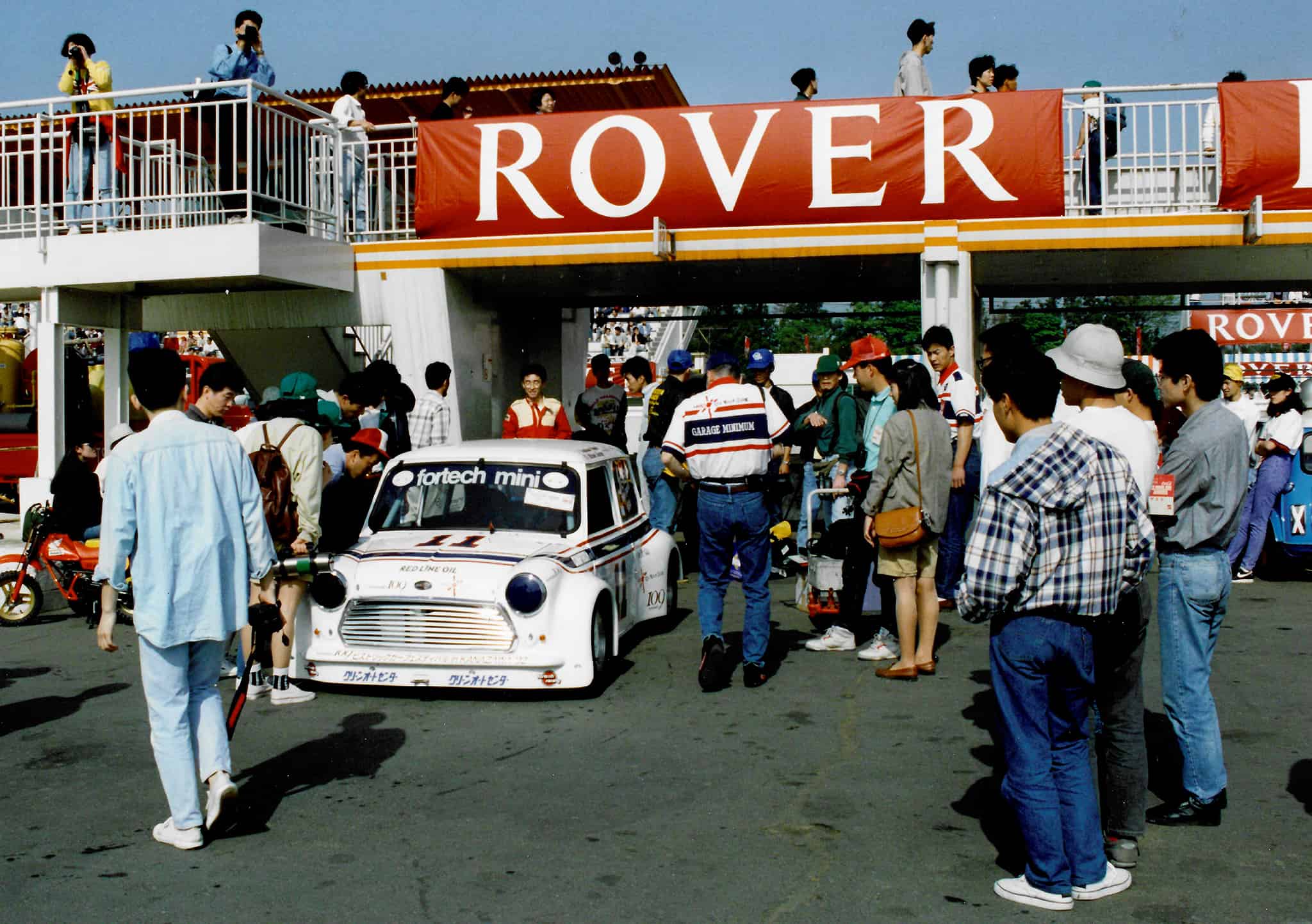 Fortech Mini always attracted a crowd of polite Japanese fans, especially when SCCA decals were given away.
Fortech Mini always attracted a crowd of polite Japanese fans, especially when SCCA decals were given away.
We had returned for round two in August. We had learned enough from the first trip to be more successful the second time out. This trip started at the famous Fuji Speedway, where we were entered to race in the 14th annual “Club 305” (the club’s name comes from the length of a Mini—three meters and five centimeters) Mini meet.
This national Mini meet has become the largest Mini meet held in Japan each year; 8000 paying spectators and 2800 Minis of all years, owned by members of two hundred and fifty Mini clubs, came to Fuji Speedway for the day of festivities.
This was our last chance to show the Japanese racers that an American Mini could be competitive, as our third scheduled appearance at the Historic Car Festival in Kanazawa in September would be simply to display the car on a podium.
RACE DAY
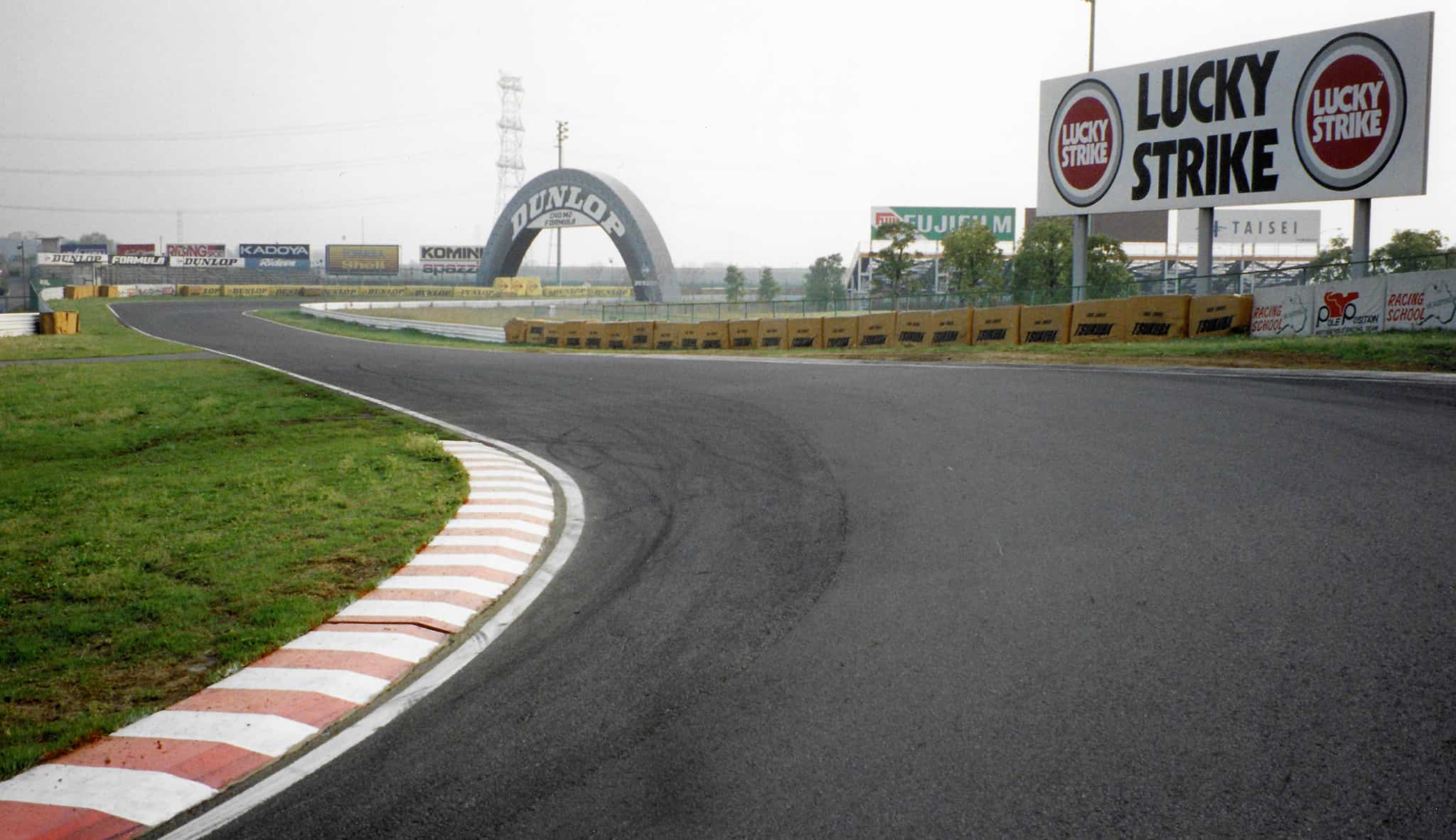 Racing in Japan is expensive, but facilities are first-rate, including closed-circuit TV and forgiving foam barriers.
Racing in Japan is expensive, but facilities are first-rate, including closed-circuit TV and forgiving foam barriers.
On the way to the Fuji racetrack, we were passed by several groups of Minis. We arrived at the track at 5 a.m., and saw about 1000 Minis in the main parking lot waiting for the gates to open at 6:30 a.m. The most Minis I had ever seen in one place before was 125, and I was really impressed. Every car there was clean, with not one paint primer spot in the entire parking lot.
The event’s organizing committee had arranged an autocross, a “Mini of the Year” contest, a demonstration race (in which we were entered), a T-shirt contest, and track time for controlled laps of the speedway for all who wished to drive around it.
Fuji Speedway is the grand old man of Japanese race circuits. Mt. Fuji can be seen from the track, and the scenery is breathtaking. It reminded me of Lake Tahoe; the mountain roads in the area are superb for touring as there are five beautiful lakes in the area and numerous quaint hotels to stay in.
Fuji Speedway is a remarkable racetrack; the grounds are huge compared to most racetracks in the U.S., and the grandstands seat 70,000. The facility includes covered garages, meeting rooms, and electronic timing via transmitters on each car. There is a fantastic scoreboard that displays every car’s lap speed. The entire grounds are clean and kept up. The track recent added new safety features to make it more FIA-user-friendly. This reputedly fast track has a very long straight with a flat-out sweeper preceding it. We were almost at red line before entering the front straight. The track is pretty straightforward to learn and most of the corners are fairly slow speed. If it wasn’t so hard on the engine (sustaining red line on the straight), it would be a great track for club racing.
Due to the lack of available track time, “Club 305” assigned starting positions based on racing experience for the first five-lap race. The starting position for the second heat was based on each driver’s finish position from the first race. There was no practice, no qualifying, not even a reconnaissance lap before the start. Forty-five cars were entered; since this was my first trip to Fuji, my experience was zero, so my starting position was 45th.
As the field was brought onto the front straight, I started to feel very nervous. I didn’t know what was at the end of the front straight, I had only seen it on the track map. However, the track became my best friend; it was very wide and had no blind corners, so I was able to learn it in a few laps. The first few laps were the most exciting of my life; passing that many Minis is something I will never forget. With each lap, I became more confident, and I eventually finished third.
I was really looking forward to the second heat race. The car that won the first race was a new Mini from Narita Racing, and it was a work of art. The preparation was first rate, with a lightweight fiberglass body chopped a couple of inches, and a K.A.D. dry sump 16-valve engine. Our Mini was giving up about 200lb and 60hp to the Narita Mini.
During the second heat, all I could think of was not to let anyone drive on the inside of me entering Turn One. The strategy worked well, and I was even able to outrun the Narita car into the turn. By Turn Four, I was leading. My next lap was the first without traffic, and I subsequently set the fastest race lap. I led the race through lap four, and, and I crossed the start/finish line, I saw the red flag displayed. The Narita car had suspension problems, and had retired in the middle of the track, so the race officials stopped the race early.
I was happy to have won the event, especially for our sponsors. Mr. Ikeda took a big chance in bringing our team to Japan to compete, but it had paid off.
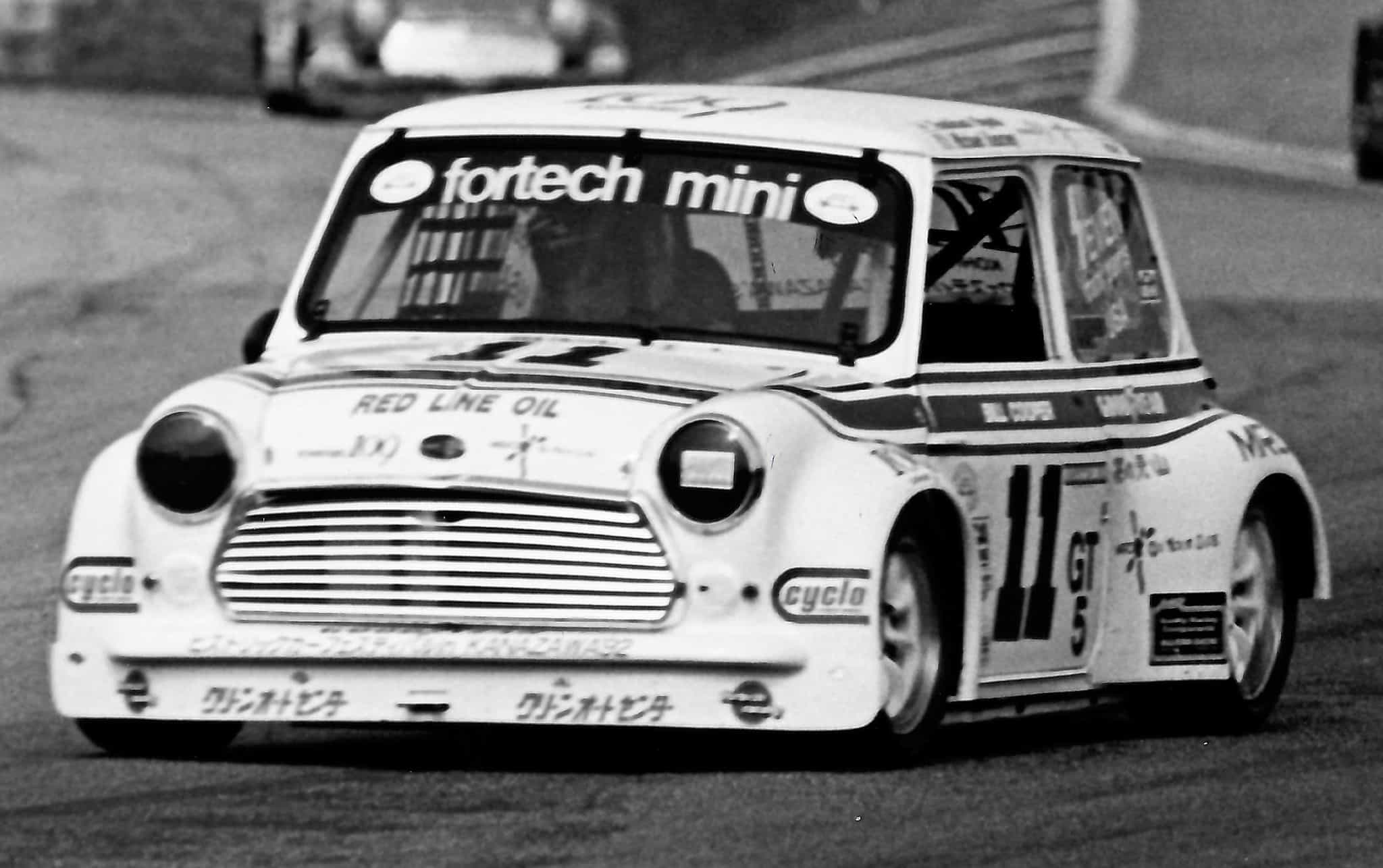 Back in the U.S., Bill Cooper recovered from a pit stop at the SCCA Valvoline Runoffs® to finish second in GT5.
Back in the U.S., Bill Cooper recovered from a pit stop at the SCCA Valvoline Runoffs® to finish second in GT5.
We wouldn’t have made this racing tour without the help of Kohei Saito, who worked hard during the three preceding years, meeting with potential sponsors, both in the U.S. and in Japan on our behalf. We learned a lot about racing in Japan in a series that has a lot of potential, in a country where racing fans will do just about anything to be at an event.
We air-freighted the Fortech Mini back to the U.S. in time to compete in the SCCA Valvoline Runoffs®, where it was driven by Bill Cooper to a second-place finish in the GT5 class.
This year (ed: 1993?), we might return to Japan to race in the Japan-Rover cup series, with a lighter, more powerful car, and have more fun in the land of the rising sun.